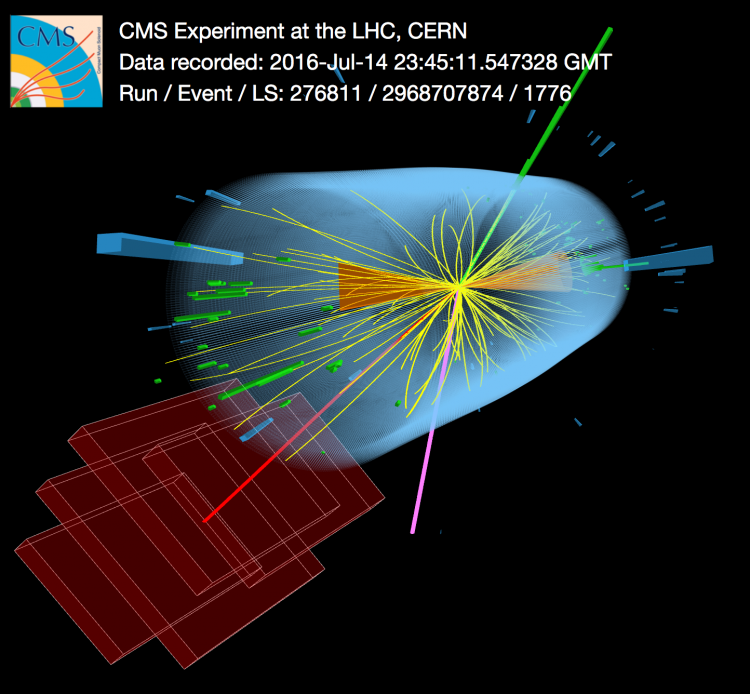CMS weighs in for the top quark
The top quark has a special position in the zoo of elementary particles, being the heaviest as well as one of the rarest fundamental particles ever sighted. With a mass of about 173 GeV, it has 40 times the mass of its partner, the bottom quark and is by far more massive than all other known quarks (up, down, strange and charm). The reason for this striking pattern of masses is not yet understood, making the study of the top quark interesting. Measuring in detail its properties can answer questions related to the gluon density at largest proton momentum fractions, allowing the top quark pole mass as well as the strong coupling strength to be determined with precision. In addition, the Standard Model makes precise predictions of the relationship between the top quark, W, Z and Higgs boson masses, and any deviations from this pattern could hint at new particles or phenomena. The discovery potential offered by the top quark makes it a clear target for the LHC experiments, as well as at future planned colliders. However, its study presents certain challenges: its high mass makes it hard to produce in large quantities even at the energies of the LHC while it has an extremely short lifetime (< 10-24 s) before it decays, dominantly into two particles, a W boson and a bottom quark.
Two recent results from ATLAS (reported in this issue HERE) and CMS collaborations shed more light on this fascinating particle and its place in the Standard Model. For the first time, CMS physicists have experimentally investigated an effect called the “running” of the top quark mass, a fundamental quantum effect predicted within the Standard Model. The fundamental parameters of the QCD Lagrangian including the strong coupling constant αS and the quark masses, are subject to renormalization which means that they depend on the scale at which they are evaluated; a phenomenom referred as "running". Although the strong coupling constant αS has previously been measured on a wide range of different scales but no experimental measurement of this property existed for the mass of the top quark. The CMS results probe this effect up to a scale of the order of 1 TeV and exclude the no-running hypothesis, that could be a sign of BSM physics, at above 95% confidence level.
CMS watching the top quark mass run

Display of an LHC collision detected by CMS that contains a reconstructed top quark-antiquark pair. The display shows an electron (green) and a muon (red) of opposite charge, two highly energetic jets (organge) and a large amount of missing energy (purple).
With a new measurement, the CMS Collaboration investigates for the first time the running of the mass of the heaviest of the quarks: the top quark. The production rate of top quark pairs (a quantity that depends on the top quark mass) was measured at different energy scales. From this measurement, the top quark mass is extracted at those energy scales using theory predictions that predict the rate at which top quark-antiquark pairs are produced.
The experimental verification of the running mass is an essential test of the validity of Quantum Chromodynamics. At the energies probed by the Large Hadron Collider, the effects of physics beyond the Standard Model could lead to modifications of the running of mass. Therefore, a measurement of this effect is also a search for unknown physics. Over the past decades, the running of the strong coupling constant has been experimentally verified for a wide range of scales. Also, evidence was found for the running of the masses of the charm and beauty quarks.

Figure 1: The running of the top quark mass determined from the data (black points) compared to the theoretical prediction (red line). As the absolute scale of the top quark mass is not relevant for this measurement, the values have been normalised to the second data point.
Experimentally, interesting top quark pair collisions are selected by searching for the specific decay products of a top quark-antiquark pair. In the overwhelming majority of cases, top quarks decay into an energetic jet and a W boson, which in turn can decay into a lepton and a neutrino. Jets and leptons can be identified and measured with high precision by the CMS detector, while neutrinos escape undetected and reveal themselves as missing energy. A collision that is likely the production of a top quark-antiquark pair as it is seen in the CMS detector is shown in Figure 1. Such a collision is expected to contain an electron, a muon, two energetic jets, and a large amount of missing energy.
The measured running of the top quark mass is shown in Figure 1. The markers correspond to the measured points, while the red line represents the theoretical prediction according to Quantum Chromodynamics. The result provides the first indication of the validity of the fundamental quantum effect of the running of the top quark mass and opens a new window to test our understanding of the strong interaction. While a lot more data will be collected in the future LHC runs starting with Run 3 in 2021, this particular CMS result is mostly sensitive to uncertainties coming from the theoretical knowledge of the top quark in Quantum Chromodynamics. To witness the top quark mass running with even higher precision and maybe unveil signs of new physics, theory developments and experimental efforts will both be necessary. In the meantime, watch the top quark run!
Further reading:
Running of the top quark mass from proton-proton collisions at sqrt(s) = 13 TeV (CMS paper TOP-19-007)
CMS Collaboration: Search for production of four top quarks in final states with same-sign or multiple leptons in proton-proton collisions at 13 TeV (Eur. Phys. J. C 80 , 2 (2020) 75, arXiv: 1908.06463)
Note: Follow the ATLAS and CMS physics briefings for more information and to get the latest results from the two experiments.
